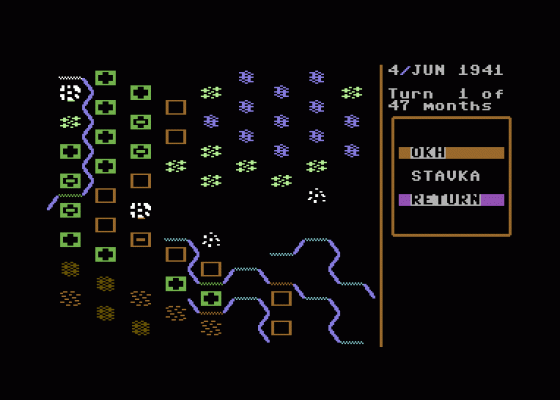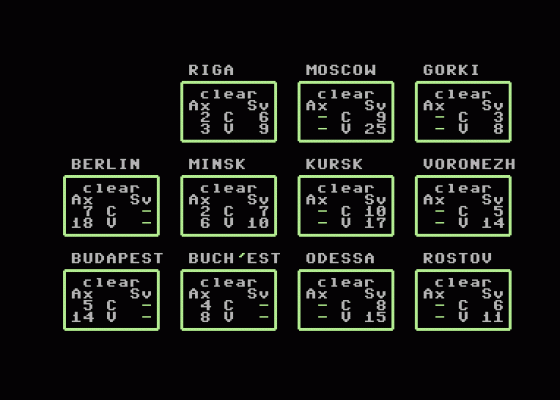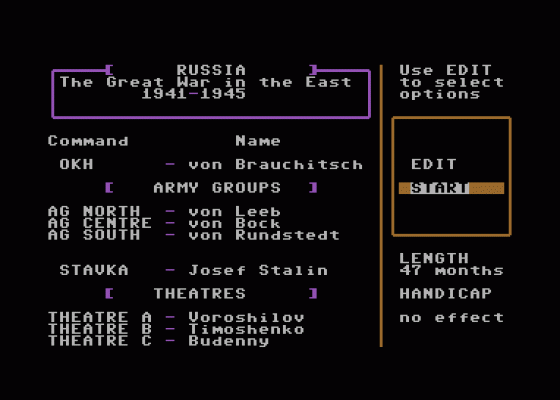
Zzap
 1st December 1987
1st December 1987
Categories: Review: Software
Publisher: Strategic Studies Group
Machine: Commodore 64
Published in Zzap #32
Russia
It was Tsar Nicholai I who passed judgement on Napoleon's failed attempt to invade Russia: "Russia has two generals in whom she can confide - General Janrier and Fevrier". It was a lesson of history which Hitler notoriously chose to ignore when he mounted his own invasion in World War II, and the Axis armies suffered heavy losses in the futile struggle against the Russian Winter.
Over four years, 50 million men fought on the Russian front. According to the introduction in the rulebook of this simulation of the campaign, 20 million of them were casualties.
Looking at the glossy package of this very traditional wargame from the Australian company SSG, the purchaser is given the immediate impression that this is a quality product of some solity. There's a 72-page rulebook, two shiny full-colour card maps showing the entire area of play with detailed terrain marking, four cards with tree diagrams of the menus that drive the game, a strip of printed labels to make your save game disk look neat, and a form which entitles the first-time buyer to a complementary copy of the house magazine 'Run 5'. All of this naturally made me expect that when I loaded the game itself I would find something that looked like it had been programmed in somebody's lunch break and took twenty minutes to process the computer's turn.

I was pleasantly surprised. On-screen, Russia looks like a traditional wargame, which tries to convince the player that army divisions are rectangular, and the speed of computer movement is wonderous.
These are the aesthetics. The game itself aims to recreate the entire four-year Axis campaign against the Russians, starting in 1941 and lasting for 48 month-long turns. To ease the baffled player into this feat of wargaming endurance, there are three shorter scenarios which, in the usual nature of these games, concentrate on smaller, specific battles. The three smaller scenarios allow you to take control of a partciular army 'group', North, Centre or South, fighting over a small portion of the map. In the campaign scenario you have control of the whole army and the freedom of much of eastern Europe.
The game is driven by a series of branching menus, which differ slightly between the scenarios and the campaign. The designers were clearly worried that some players might get lost amid the trees, and so diagrams are provided for startup, game designing, and playing. To give some idea of the system's complexity, there are eighteen menus associated with playing a scenario. This is a headache to get to grips with at first, but I found that I familiarised myself with the order of play surprisingly quickly. One chapter of the extensive rulebook takes the player through the first turn of the Leningrad scenario step-by-step, and although this took me about three quarters of an hour to work through, I was able to enter subsequent turns in no time.

After the usual preliminaries of choosing a difficulty level - you can opt for a minor, moderate or major advantage to either side, which is worked out in terms of troop numbers - the player is launched straight into twelve sectors, and the scenario takes place on three or four of them (one sector corresponds to what fills a screen). Terrain is represented in an unobjectionable sort of way, but the display is enhanced by the printed map which comes with the package. It is useful too for identifying cities. My one complaint about the screen display - and it's a fairly strong one - is that cities are not shown clearly enough. The whole of the gameplay is centred around the pursuit and capture of cities, and it's very difficult to actually see them properly on the screen.
For some reason they have been drawn as a collection of neutral grey blotches, and they blend into the scenery. I would like to see large, solid, red beacons!
The units are shown as rectangles occupying a single hex. There's a degree of limited intelligence, and you can see more or less what type of troops your opponent has - whether they're tanks or infantry - but only the controlling player can see the specific classification.

One of the menus allows access to a number of information screens, and you can call up displays onto the map showing the communication value for the hexes, railway lines, the controlling side of each hex, and what the map would look like if it wasn't cluttered up with units. The amount of information available for inspection is formidable and, at first, rather alarming.
The Axis army is divided into three army groups, which can consist of up to six 'armees'. The armees can in turn control six korps. There's a kind of command hierarchy because this can be confusing at first, and the player has to give orders at two different levels. An unusual feature is that you don't actually tell units to go to particular hexes, so you can't fight the enemy by arranging your units in pretty patterns of your own choosing. Each armee is given a general 'doctrine', which determines what its aim will be. 'Main Effort' is the signal for an offensive, and when this is chosen the armee is targetted on a vicinity within seven hexes - less, in adverse weather conditions - for the armee headquarters. Thereafter, until the city is captured or the armee's doctrine is changed, the korps units attached to that armee move forward in an attempt to reach and capture their objective. If enemy units get in the way, they fight them. Their exact course is determined by the computer and is not under the player's control at all.
The armee doctine can be 'normal', in which case it does little, but is still able to fight well, or it can be ordered to rest, which enable the troops to recover their strength quickly, but puts the korps at a disadvantage if they're attacked.

Once the armee doctrine has been selected, the player gives orders to each individual unit or 'korps'. The range of options open to the korps is determined by what the armee doctrine is, and whether or not the unit is next to an enemy unit. Next to the enemy, a korps whose armee is on 'main effort' can assault, probe, defend or retreat, and the player allocates ground support and air support in points.
The condition of each korps is given in a general way. Surprisingly, there is no indication of exact numbers of men: the state of the unit is described in terms of the troops' combat experience and their fitness. Casualties are given in the battle reports, but there seems to be no way of referring back to this.
Each armee has an individual supply of ground support units which can be distributed to the korps, and the air supply units come out of a general army group pool. If the supply lines of a korps get cut off, they can't replenish their OSPs, but their supply of ASPs is unaffected. The provision of basic supply points is affected by supply lines, too, and a novel statistic is the 'administration' factor. This is an indication of how organised and ready for combat a korps is. According to the instructions, the maximum value of seven means that 'all the forms are filled out and the army camp barber has sharpened his razor'! When the fighting starts, things gradually become more disorganised. An armee can't launch into 'main effort' unless its administrations and supply points are high enough, and low values make them vulnerable.
After adjusting armee doctrines and giving individual korps orders, the player wades back through the menus and hits 'Run 5'. This command seems to be the SSG buzzword, and executes the turn. Battles are resolved, and the player's and the computer's units move instantaneously and simultaneously. No staring at the wallpaper - it's over in seconds!
The program provides full facilities to create your own scenarios. Because you can alter almost every single variable, including the point values of cities, with enough patience and interest you can set up for any Russian Front battle. Although I haven't seen a copy, the company magazine 'Run 5' prints statistics for further scenarios.
Everything the full-blooded wargamer could want has been provided in this game, and moreover it's easy to handle once you've learned the system. Nothing interrupts or irritates - except perhaps the choo-choo noise of units travelling by rail - and I found it completely absorbing. Definitely a worthwhile investment.
Verdict
Presentation 91%
Beautiful physical components, smooth operation and thoughtful touches.
Graphics 75%
Pleasant enough, although the cities are unclear on the map screen.
Rules 90%
A lack of extensive historical information is made up for by the extremely thorough descriptions of the game mechanics.
Playability 89%
The branching menu system, once learned, makes play fast and compelling.
Overall 91%
One of the best traditional wargames I've seen - thoroughly recommended.
Other Reviews Of Russia: The Great War In The East 1941-1945 For The Commodore 64
Russia (SSG)
A review by Mark Patterson (Commodore User)


